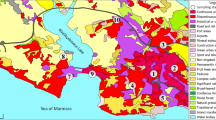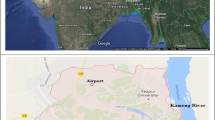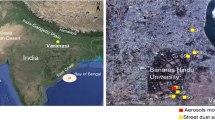Abstract
Total suspended particle (TSP) collected at the fifth floor of House Dust in Hunan University, China, was analyzed in terms of microscopic morphology and chemical composition. The fine particles (50 nm–2 μm) in the TSP were analyzed by a high-resolution transmission electron microscope equipped with an energy-dispersive X-ray analyzer (HRTEM/EDS). Results showed that the particles were in shapes of plate, irregular and agglomerate. Based on EDS results, these fine particulate matter was primarily composed of Fe-rich (35.82–61.29%), Ca-rich (30.18–36.77%) and Si-rich (18.95–32.28%) particles. Other elements mainly including Mg (0.47–4.97%), Al (0.45–14.57%), S (0.45–4.73%), K (1.13–2.13%) and Zn (0.67–3.85%) were also observed. The sources analysis indicated that the HRTEM particles mainly originated from coal combustion, traffic emission, vehicles exhaust emission and fugitive soil or cement particulate matter. The coarse particles (4–50 μm) were detected by environmental scanning electron microscopy coupled with energy-dispersive X-ray detector (ESEM/EDS). Based on a simple algorithm, ESEM particles were categorized into five groups: C-bearing (46.15%, 67% and 86.98%), Si + Ca-bearing (21.48 + 11.80%, 16.51 + 10.81% and 16.32 + 10.62%), Si + Al-bearing (20.06 + 12.40%, 20.16 + 11.22% and 15.31 + 11.25%), Si-bearing (34.40%, 26.92% and 27.15%) particles and aggregates, most of which exhibit obvious crystalline structure, and these ESEM particles mainly derived from vehicles exhaust emission, coal combustion, soil, and biomass burning, while the aggregates are indicative of atmospheric reaction progress. HRTEM/EDS and ESEM/EDS are mutual complementary in analyzing the characteristic and determining the sources of TSP.





Similar content being viewed by others
References
Alastuey, A., Querol, X., Rodrí, S., Plana, F., Lopez-Soler, A., Ruiz, C., & Mantilla, E. (2004). Monitoring of atmospheric particulate matter around sources of secondary inorganic aerosol. Atmospheric Environment, 38, 4979–4992.
Almeida, S. M., 2004. Composition and sources of atmospheric aerosol in an urban/industrial region. Ph.D. Thesis, University of Aveiro, Portugal (in portuguese).
Almeida, S. M., Pio, C. A., Freitas, M. C., Reis, M. A., & Trancoso, M. A. (2005). Source apportionment of fine and coarse particulate matter in a sub-urban area at the Western European Coast. Atmospheric Environment, 39, 3127–3138.
Amato, F., Pandolfi, M., Viana, M., Querol, X., Alastuey, A., & Moreno, T. (2009). Spatial and chemical patterns of PM10 in road dust deposited in urban environment. Atmospheric Environment, 43, 1650–1659.
Bogo, H., Otero, M., Castro, P., Ozafrán, M. J., Kreiner, A., Calvo, E. J., & Martin Negri, R. (2003). Study of atmospheric particulate matter in Buenos Aires city. Atmospheric Environment, 37, 1135–1147.
Brewer, R., & Belzer, W. (2001). Assessment of metal concentrations in atmospheric particles from Burnaby lake, British Columbia, Canada. Atmospheric Environment, 35, 5223–5233.
Chang, H., Yang, S. J., Dong, J. Q., & Wang, S. C. (2000). Study on the element species of atmosphere aerosol. Environmental Chemistry, 19, 485–499 (in Chinese).
Chen, J. F., 2005. Characteristics of high-alumina fly ash and its use in synthesis of mullite: a case from the Jungar Power Plant in Inner Mongolia, North China. Ph. D. Thesis, China University of Mining and Technology, Beijing, 8–59 (in Chinese).
Chueinta, W., Hopke, P. K., & Paatero, P. (2000). Investigation of sources of atmospheric aerosol at urban and suburban residential areas in Thailand by positive matrix factorization. Atmospheric Environment, 34, 3319–3329.
Dai, S. F., Zhao, L., Peng, S. P., Chou, C. L., Wang, X. B., Zhang, Y., Li, D., & Sun, Y. Y. (2010). Abundances and distribution of minerals and elements in high-alumina coal fly ash from the Jungar Power Plant, Inner Mongolia, China. International Journal of Coal Geology, 81, 320–332.
Desboeufs, K. V., Sofikitis, A., Losno, R., Colin, J. L., & Ausset, P. (2005). Dissolution and solubility of trace metals from natural and anthropogenic aerosol particulate matter. Chemosphere, 58, 195–203.
Ekosse, G., van den Heever, D. J., de Jager, L., & Totolo, O. (2004). Environmental chemistry and mineralogy of particulate air matter around Selebi Phikwe nickel-copper plant, Botswana. Minerals Engineering, 17, 349–353.
Esbert, R. M., Diaz-Pache, F., Grossi, C. M., Alonso, F. J., & Ordaz, J. (2001). Airborne particulate matter around the Cathedral of Burgos (Castilla y León, Spain). Atmospheric Environment, 35, 441–452.
Fernandez-Turiel, J. L., Georgakopoulos, A., Gimeno, D., Papastergios, G., & Kolovos, N. (2004). Ash deposition in a pulverized coal-fired power plant after high-calcium lignite combustion. Energy & Fuelsn, 18, 1512–1518.
Galbreath, K. C., & Zygarlicke, C. J. (2004). Formation and chemical speciation of arsenic-, chromium-, and nickelbearing coal combustion PM2.5. Fuel Processing Technology, 85, 701–726.
Ganor, E., Levin, Z., & Van Grieken, R. (1998). Composition of individual aerosol particles above the Israelian Mediterranean coast during the summer time. Atmospheric Environment, 32, 1631–1642.
Georgakopoulos, A., Filippidis, A., & Kassoli-Fournaraki, A. (1994). Morphology and trace element contents of the fly ash from Main and Northern lignite fields, Ptolemais, Greece. Fuel, 73, 1802–1804.
Gomes, S., & François, M. (2000). Characterisation of mullite in silicoaluminous fly ash by XRD, TEM, and 29Si MAS NMR. Cement and Concrete Research, 30, 175–181.
Gomes, S., François, M., Abdelmoula, M., Refait, P., Pellissier, C., & Evrard, O. (1999). Characterisation of magnetite in silico-aluminous fly ash by SEM, TEM, XRD, magnetic susceptibility, and Mössbauer spectroscopy. Cement and Concrete Research, 29, 1705–1711.
Griffin, D. W., Garrison, V. H., Herman, J. R., & Shinn, E. A. (2001). African desert dust in the Caribbean atmosphere: microbiology and public health. Aerobiologia, 17, 203–213.
Hoffman, R. C., Laskin, A., & Finlayson-Pitts, B. J. (2004). Sodium nitrate particles: physical and chemical properties during hydration and dehydration, and implications for aged sea salt aerosols. Journal of Aerosol Science, 35, 869–887.
Hoffmann, V., Knab, M., & Appel, E. (1999). Magnetic susceptibility mapping of roadside pollution. Journal of Geochemical Exploration, 66, 313–326.
Hower, J. C., Rathbone, R. F., Robertson, J. D., Peterson, G., & Trimble, A. S. (1999). Petrology, mineralogy, and chemistry of magnetically-separated sized fly ash. Fuel, 78, 197–203.
Hueglin, C., Gehrig, R., Baltensperger, U., Gysel, M., Monn, C., & Vonmont, H. (2005). Chemical characterisation of PM2.5, PM10 and coarse particles at urban, near-city and rural sites in Switzerland. Atmospheric Environment, 39, 637–651.
Iordanidis, A., Garcia-Guinea, J., & Lopez-Arce, P. (2004). Analysis of lignite and claystone mixtures in view of their possibleuse in brick-making. Industrial Ceramics, 24, 191–197.
Iordanidis, A., Buckman, J., Triantafyllou, A. G., & Asvesta, A. (2008). ESEM-EDX characterisation of airborne particles from an industrialised area of northern Greece. Environmental Geochemistry and Health, 30, 391–405.
Jones, R., Booth, A. P. P. G., & McCarthy, A. (2006). Characteristics of the ultrafine component of fly ash. Fuel, 85, 2250–2259.
Kellogg, C. A., Griffin, D. W., Garrison, V. H., Peak, K. K., Royall, N., Smith, R. R., & Shinn, E. A. (2004). Characterization of aerosolized bacteria and fungifrom desert dust events in Mali, West Africa. Aerobiologia, 20, 99–110.
Laversin, H., Courcot, D., Ledoux, F., Courcot, L., Zhilinskaya, E. A., Cazier, F., Baushina, S., Desmonts, T., Aisi, F., Puskaric, E., Aboukais, A., 2005. Investigation of atmospheric particle sources in urban and industrialized area at Dunkerque, France. In: Topcu, et al. (Ed.), Proceedings of the 3 rd International Symposium on Air quality Management at Urban, Regional and Global Scales, 26–30 Sept 2005, Istanbul, Turkey, pp. 700–709.
Lee, S. W., He, I., & Young, B. (2004). Important aspects in source PM2.5 emissions measurement and characterization from stationary combustion systems. Fuel Processing Technology, 85, 687–699.
Li, W. J., Shao, L. Y., Wang, Z. S., Shen, R. R., Yang, S. S., & Tang, U. (2010). Size, composition, and mixing state of individual aerosol particles in a South China coastal city. Journal of Environmental Sciences, 22, 561–569.
Lu, S. G., Zheng, Y. W., & Bai, S. G. (2008). A HRTEM/EDX approach to identification of the source of dust particles on urban tree leaves. Atmospheric Environment, 42, 6431–6441.
Martinez, T., Lartigue, J., Avila-Perez, P., Carapio-Morales, L., Zarazua, G., Navarrete, M., Tejeda, S., & Cabrera, L. (2008). Charaterization of particulate matter from the Metropolitan Zone of the Valley of Mexico by scanning electron microscopy and energy dispersive X-ray analysis. Journal of Radioanalytical and Nuclear Chemistry, 3, 799–806.
McNeilly, J. D., Heal, M. R., Beverland, I. J., Howe, A., Gibson, M. D., Hibbs, L. R., MacNee, W., & Donaldson, K. (2004). Soluble transition metals cause the pro-inflammatory effects of welding fumes in vitro. Toxicology and Applied Pharmacology, 196, 95–107.
Moreno, N., Querol, X., Andres, J. M., Stanton, K., Towler, M., Nugteren, H., Janssen-Jurkovicová, M., & Jones, R. (2005). Physico-chemical characteristics of European pulverized coal combustion fly ashes. Fuel, 84, 1351–1363.
Paoletti, L., Berardis, B. D., & Diociaiuti, M. (2002). Physicochemical characterization of the inhalable particulate matter (PM10) in an urban area: An analysis of the seasonal trend. Science of the Total Environment, 292, 265–275.
Pope, C. A., Burnett, R. T., Thun, M. J., Calle, E. E., Krewski, D., Ito, K., & Thurston, G. D. (2002). Lung cancer, cardiopulmonary mortality, and long-term exposure to fine particulate air pollution. The Journal of the American Medical Association, 287, 1132–1141.
Querol, X., Alastuey, A., Puicercus, J. A., Mantilla, E., Ruiz, C. R., Lopez-Soler, A., Plana, F., & Juan, R. (1998). Seasonal evolution of suspended particles around a large coal-fired power station: chemical characterization. Atmospheric Environment, 30, 3557–3572.
Richards, R. J., Atkins, J., Marrs, T. C., Brown, R. F. R., & Masek, L. C. (1989). The biochemical and pathological changes produced by the intratracheal instillation of certain components of zinc-hexachloroethane smoke. Toxicology, 54, 79–88.
Schwartz, J. (1994). Air pollution and daily mortality: a review and meta analysis. Environmental Research, 64, 36–52.
Schwartz, T., Jungfer, C., Heißler, S., Friedrich, F., Faubel, W., & Obst, U. (2009). Combined use of molecular biology taxonomy, Raman spectrometry, and ESEM imaging to study natural biofilms grown on filter materials at waterworks. Chemosphere, 77, 249–257.
Semeniuk, T. A., Wise, M. E., Martin, S. T., Russell, L. M., & Buseck, P. R. (2007). Water uptake characteristics of individual atmospheric particles having coatings. Atmospheric Environment, 41, 6225–6235.
Shao, L. Y., Li, J. J., Zhao, H. Y., Yang, S. S., Li, H., Li, W. J., Jones, T., Sexton, K., & BéruBé, K. (2007). Associations between particle physicochemical characteristics and oxidative capacity: an indoor PM10 study in Beijing, China. Atmospheric Environment, 41, 5316–5326.
Shao, L. Y., Li, W. J., Yang, S. S., Shi, Z. B., & Lü, S. L. (2007). Mineralogical characteristics of airborne particles collected in Beijing during a severe Asian dust storm period in spring 2002. Science in China Series D: Earth Sciences, 50, 953–959.
Shi, Z. B., Shao, L. Y., Jones, T. P., Whittaker, A. G., Lu, S. L., Bérubé, K. A., He, T., & Richards, R. J. (2003). Characterization of airborne individual particles collected in an urban area, a satellite city and a clean air area in Beijing, 2001. Atmospheric Environment, 37, 4097–4108.
Shigemoto, N., Sugiyama, S., Hayashi, H., & Miyaura, K. (1995). Characterisation of Na-X, Na-A, and coal fly ash zeolites and their amorphous precursors by IR, MAS NMR and XPS. Journal of Materials Science, 30, 5777–5783.
Sternbeck, J., Sjödin, A., & Andréasson, K. (2002). Metal emission from road traffic and the influence of resuspension—results from two tunnel studies. Atmospheric Environment, 36, 4735–4744.
Torfs, K., & Van Grieken, R. (1997). Chemical relations between atmospheric aerosols, deposition and stone decay layers on historic buildings at the Mediterranean coast. Atmospheric Environment, 31, 2179–2192.
Triantafyllou, A. G. (2003). Levels and trend of suspended particles around large lignite power stations. Environmental Monitoring and Assessment, 89, 15–34.
Trimbacher, C., & Weiss, P. (1999). Needle surface characteristics and element contents of Norway spruce in relation to the distance of emission sources. Environmental Pollution, 105, 111–119.
Tsitouridou, R., & Anatolaki, C. (2007). On the wet and dry deposition of ionic species in the vicinity of coal-fired power plants, northwestern Greece. Atmospheric Research, 83, 93–105.
Veranth, J. M., Fletcher, T. H., Pershing, D. W., & Sarofim, A. F. (2000). Measurement of soot and char in pulverized coal fly ash. Fuel, 79, 1067–1075.
Wätjen, W., Haase, H., Biagioli, M., & Beyersmann, D. (2002). Induction of apoptosis in mammalian cells by cadmium and zinc. Environmental Health Perspectives Supplements, 110, 865–867.
Xie, R. K., Seip, H. M., Leinum, J. R., Winje, T., & Xiao, J. S. (2005). Chemical characterization of individual particles (PM10) from ambient air in Guiyang City, China. Science of the Total Environment, 343, 261–272.
Yao, X. H., Chan, C. K., Fang, M., Cadle, S., Chan, T., Mulawa, P., He, K., & Ye, B. (2002). The water-soluble ionic composition of PM2.5 in Shanghai and Beijing, China. Atmospheric Environment, 36, 4223–4234.
Zhang, R. J., Han, Z. W., Cheng, T. T., & Tao, J. (2009). Chemical properties and origin of dust aerosols in Beijing during springtime. Particuology, 7, 61–67.
Zhao, Y. C., Zhang, J. Y., Sun, J. M., Bai, X. F., & Zheng, C. G. (2006). Mineralogy, chemical composition, and microstructure of ferrospheres in fly ashes from coal combustion. Energy & Fuels, 20, 1490–1497.
Acknowledgments
This work was supported by National Natural Science Foundation of China (50908080, 51108169), Hunan Provincial Natural Science Foundation of China (11JJ2032), and the Fundamental Research Funds for the Central Universities and Supported by Doctoral Fund of Ministry of Education of China (grant no. 20090161120042), the Project of Humanities and Social Sciences of Chinese Ministry of Education (grant no. 09YJC790078). The authors would like express their gratitude to Materials Testing Center Hunan University for providing testing instrument.
Author information
Authors and Affiliations
Corresponding author
Rights and permissions
About this article
Cite this article
Zhai, Y., Fu, Z., Wang, L. et al. Characteristic, composition, and sources of TSP investigated by HRTEM/EDS and ESEM/EDS. Environ Monit Assess 184, 6693–6707 (2012). https://doi.org/10.1007/s10661-011-2452-5
Received:
Accepted:
Published:
Issue Date:
DOI: https://doi.org/10.1007/s10661-011-2452-5




